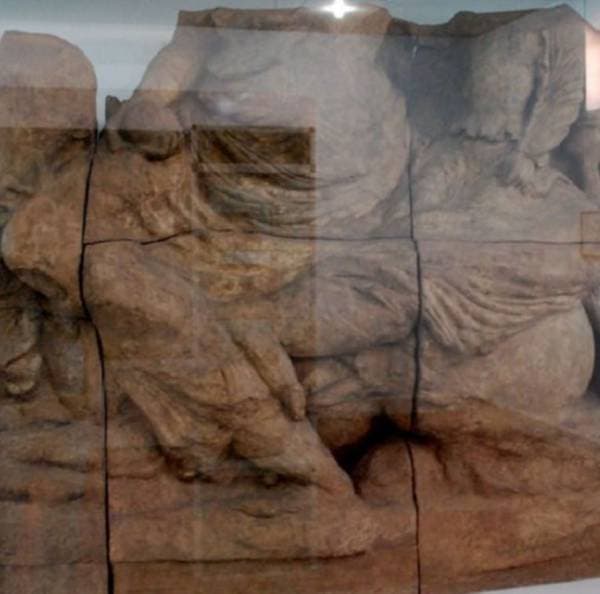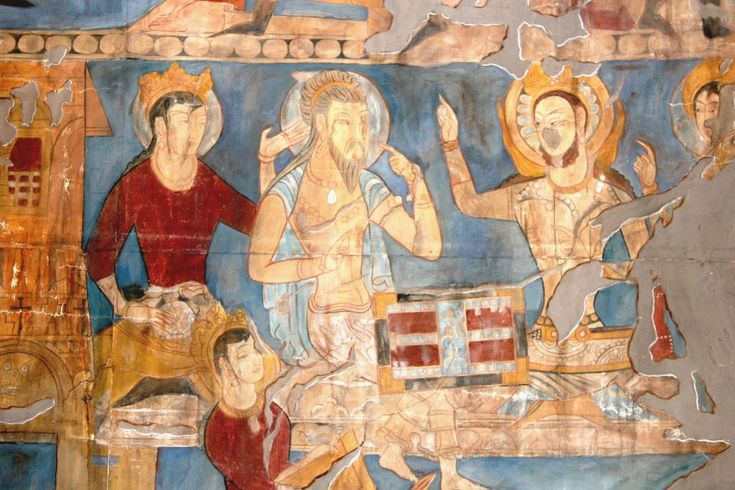Hinduism in Tajikistan
This is a gigantic 5th-8th century Murti of Lord Shiva and Parvati from Central Asia. It has been excavated by Archaeologists in Penjikent, Tajikistan. It Is Presently In Dushanbe, National Museum of Antiquities.

Central Asia has a long history of Shiva worship. The Kushan emperor Vima Kadphises was perhaps one of the earliest Central Asian Worshipers of Shiva. All his coins depicted Shiva and no other deity featured on his coins. It was perhaps the Kushans who introduced Shiva worship in Central Asia. And he became a popular deity among ancient Sogdians who made this huge Murti. Around the 8th century, Islam entered Central Asia and the idol has been beheaded. Shiva’s native worship has never again been heard of in Central Asia.
Note that Kushans invaded India. But not only did they adopt Indian Culture, but they also took it back to their Central Asian homelands.

Yudhiṣṭhira playing dice with Shakuni. A wall painting from Pre-Islamic Tajikstan in Panjikent.
Since Central Asian nations opened up in the 1990s, they became sources of new archaeological discoveries. Buddhist discoveries were expected, but few expected a strong Hindu influence between 1st and 7th century AD or the Sogdian admiration for ancient India.
Here are some Sogdian-era findings from Tajikstan–Uzbekistan border region:
- Sogdians loved frescoes and art in their homes and public buildings. These included scenes from Panchatantra and Mahabharata.
- The homes of elites and the site now called “Hall of the Ambassadors” of Panjikant in Tajikstan is full of Indian artwork, particularly Hindu art. These include Hindu gods, goddesses as well as Nana etc. Notably, Zorastrian gods are frequently depicted with Hindu motifs.
- Maria Slautina writes, “When a Sogdian artist had to represent a very distant land, a fairytale land where only marvels are possible, he often chose India”.
- The Panjikant and nearby sites such as Samarkand were notable “melting pot” of different Asian cultures before 700 AD, exchanging goods and ideas. This is evidenced by the Hindu scenes presented along with Buddhist, Old Persian, and some from China. The medical literature found is in Sanskrit, written in Brahmi script. This region was on the Silk route frequented by traders and merchants.
- Sogdian inscriptions have recently been discovered in west Kashmir and northwest Pakistan. Sogdians are probably the same as Sulikas (Chulikas) in the Mahabharata, which if true would attest to their ancient connections to India.
- A few scholars had speculated before the 1980s that ancient Chulikas may have become the famous Chalukyas of Karnataka–Telangana region, their only evidence being that the names sound similar. But, recent discoveries suggest that Chalukyas have nothing in common with Sogdians. The Sogdian art is closer to Hindu art found in Kashmir–Gandhara.
- Sogdian culture and art ended abruptly around 722 AD, after the region was conquered by an Islamic army. The artwork was mutilated, the wealthy towns plundered and destroyed.
Source:
- https://trueindologytwitter.wordpress.com/2020/03/21/lord-shiva-idol-in-tajikistan/
- https://en.wikipedia.org/wiki/Penjikent_murals
- https://x.com/TrueIndology/status/1804149315251601598
- https://x.com/tapeshyadav_usa/status/1761971733551305209
- M Slautina, Sogdians – The Cultural Bees of Central Asia, Freer-Sackler Project
- F Grenet, Iranian Gods in Hindu Garb (Bactrians & Sogdians), CNRS
- N Sims-Williams, Sogdian & other Iranian Inscriptions of the Upper Indus
- F Grenet, Last Days of Panjikent